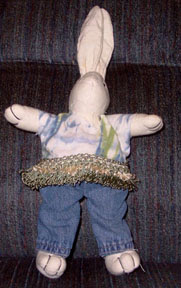 It's always interesting to me to watch Juniper and Boodles when we go on our daily walks. Boodles always has her nose to the ground- scent is everything to her. She follows her nose and her trail meanders like a drunken sailor. The undersides of bushes fascinate her, and she vanishes into hedges at the speed of light. Her world narrows to what she can smell.
It's always interesting to me to watch Juniper and Boodles when we go on our daily walks. Boodles always has her nose to the ground- scent is everything to her. She follows her nose and her trail meanders like a drunken sailor. The undersides of bushes fascinate her, and she vanishes into hedges at the speed of light. Her world narrows to what she can smell.Juniper, on the other hand, is all eyes. She walks sedately, all four feet in a straight line, head up, surveying the surroundings. She hardly ever puts her nose to the ground, although she will sometimes point it at the sky and take deep sniffs.
We don't know what Boodle's genetic heritage is. We suspect some St. Bernard, based on facial coloring, but truthfully, she could be a mix of anything. Somewhere, however, a scent hound lurks in her background. The Wikipedia article about olfaction, the sense of smell, found here has this to say:
"Dogs in general have a nose approximately a hundred thousand to a million times more sensitive than a human's. Scenthounds as a group can smell one- to ten-million times more acutely than a human, and Bloodhounds, which have the keenest sense of smell of any dogs, have noses ten- to one-hundred-million times more sensitive than a human's. They were bred for the specific purpose of tracking humans, and can detect a scent trail a few days old. The second-most-sensitive nose is possessed by the Basset Hound, which was bred to track and hunt rabbits and other small animals."
You can tell those dogs who rely heavily on scent for information- they are the drooly ones. All dog noses are damp, to attract and hold scent molecules. Scent hounds go a little further- providing extra moisture. They generally have loose, saggy lips, and droopy ears to better stir air currents and bring scent molecules up to the nose. All of those things that make a Bloodhound recognizable as a Bloodhound are bred in to make their ability to scent track better- long floppy ears, wet drooly mouth with droopy lips and loose neck skin. Even the floppy skin that makes them look so comical is there for a reason- when the dog's nose is to the ground, the skin falls forward, reducing the field of vision so there are fewer distractions from the scent trail.
Saint Bernard's don't have quite as many scent adaptations, but the do have the drooping, drooly mouths. To read an amusing article about training Saint Bernard's to scent track, click here
We do know about Juniper's genetic heritage- Akita, Lab and Rottweiler. All hunting dogs- working dogs with high prey drives who use their eyes. Desmond Morris, author of Dog Watching writes "Another difference between our eyes and theirs is that they are more sensitive to movement and less so to detail. If something stands still when at a good distance from them, it becomes almost invisible. This is why so many prey species "freeze" and stand motionless when they become alarmed, before trying to flee. Tests have proved that if a dog's owner remains motionless at a distance of three hundred yards the animal cannot detect him. If, on the other hand, a shepherd is one mile distant but making bold hand signals, these can be clearly seen by this sheepdog. This sensitivity to movement is, of course, of paramount importance during the long chases when wild dogs are on the hunt. Once the prey is fleeing, the dog's eyes are at their peak of performance.
An additional aid for the hunting dog is its much wider field of vision. A narrow-headed breed like a greyhound has a visual range of 270 degrees. A more typical dog has a visual range of 250 degrees. Flat-faced dogs have slightly less. But they all have more than human beings, whose visual field is only 180 degrees. Although this means that dogs can detect small movements over a much wider slice of the landscape, they have to pay for this with a narrower range of binocular vision, a range that is only half the width of ours. So we are better at judging distances than they are."
I'm really fairly new to dog walking, despite having had dogs for most of my life. When we had the pack of 4 dogs we had a huge fenced yard and small children- dog walking was not the priority then that I know now know it should be. Our last dog was our son's, and roller blading was his favorite form of exercise. When Bart went off to college, Jerehmiah took over the dog walking; it didn't become my job until Jerehmiah left home and Ender was elderly. Until I walked these two very different dogs together, I never noticed the effects of breeding and genetics at work.






No comments:
Post a Comment